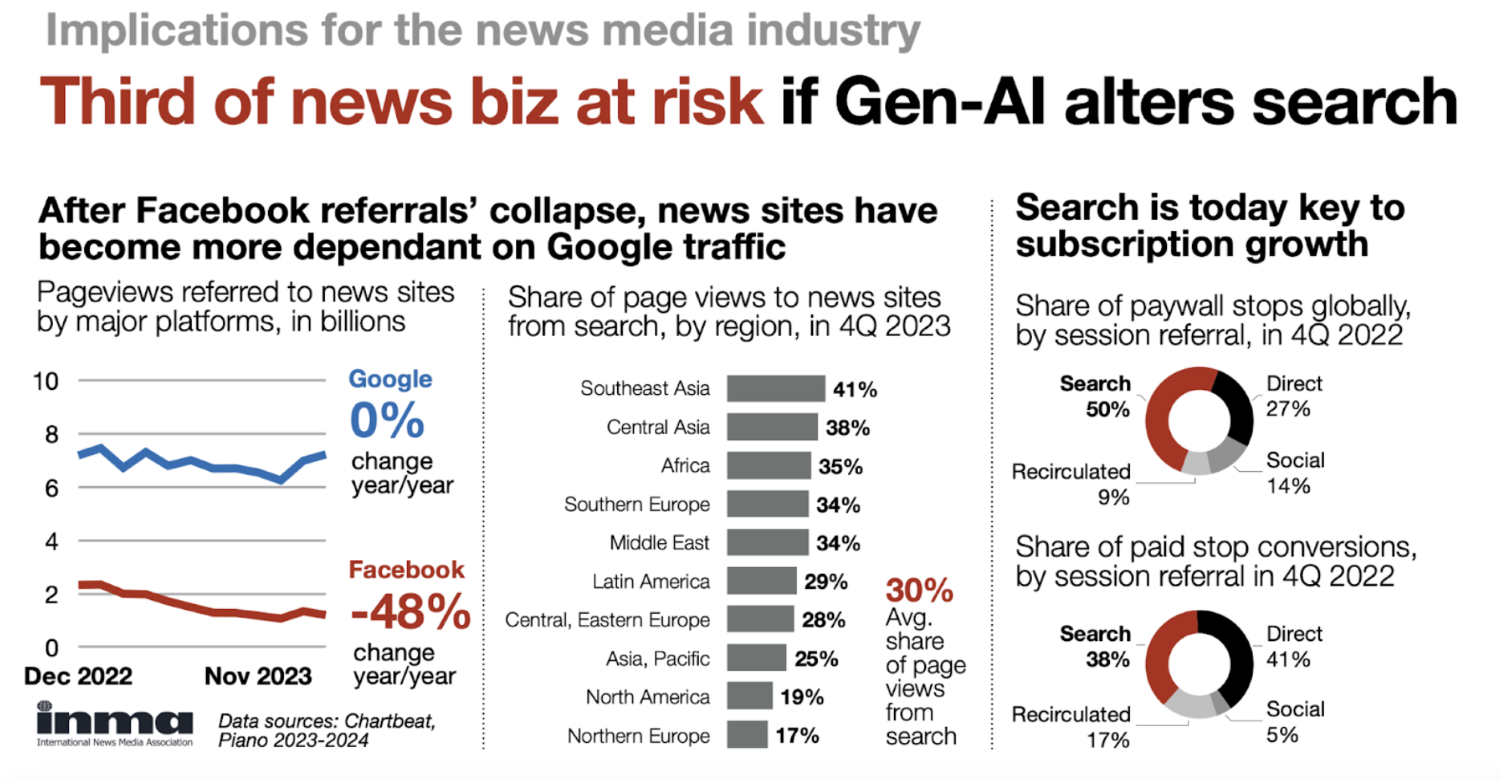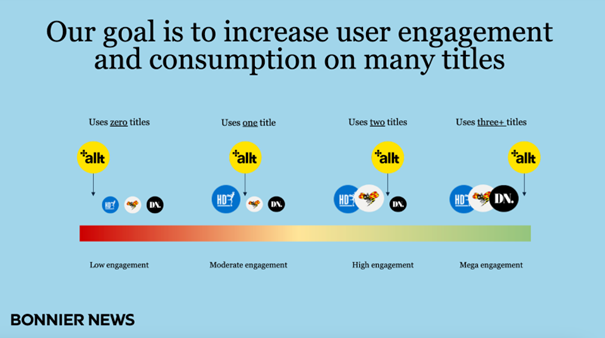Are you wondering what the future of news subscriptions holds? Well, we are, every day. Thanks to Rado Augustin, the Head of Product at Denník N, and the valuable insights he gathered at the INMA Media Subscriptions Summit in New York, we've gained fresh insights. And we don't want to keep them to ourselves, so keep on reading for his main takeaways that could redefine your understanding of the subscription landscape.
What you'll learn:
- How current data disproves common myths about the decline of online news and subscription limits.
- Effective strategies for enhancing subscriber retention and growth through branding and paywall integration.
- The benefits of bundling content to increase subscription value and encourage deeper user engagement.
Busting the subscription future myths
One of the highlights was for sure the presentation of Greg Piechota, a Researcher-In-Residence at INMA and an esteemed expert on subscription models. Many believe the publishing sector is in decline, but the summit successfully debunked these myths. Greg's presentation of the INMA survey showcased that perceptions about the market might indeed cloud media executives’ judgment.
Myth n. 1: Nobody cares about online news anymore
Fact: Statistics actually show that people are still highly interested in online news. While there was a slight dip since 2020, we're essentially back to pre-pandemic levels. Moreover, with major events like elections and the Olympics on the horizon, further growth is anticipated.

Myth n. 2: Publishers are facing the rise of “news avoidance”
Fact: While it might appear that a growing number of people are turning away from news consumption altogether, the reality is that these news avoiders typically have limited potential for subscription-based engagement. They often exhibit lower levels of education, economic resources, or interest in politics. So, there is no need to feel threatened by the news avoidance trend - they might not be your target audience anyway.
Myth n. 3: Consumers are overwhelmed and frustrated with subscriptions
Fact: Data suggests otherwise - people are still loving their subscriptions, whether it's for streaming or digital news. Since 2019, digital-only subscriptions have grown exponentially. With sales per user doubling and low churn rates, there's little evidence of subscription fatigue.
Myth n. 4.: Young people don’t pay for news
Fact: Globally, more people aged 18-34 pay for online news than older age groups. Although young people typically don't pay for traditional publishing houses, they are willing to pay for interesting newsletters, podcasts, and other subscription formats that differ from the classic ones. The challenge for publishers is to adapt the content and its forms to the younger generation, tapping into their preferences and habits.
Myth n. 5: Publishers hit a ceiling and can't grow subs any more
Fact: We're not even close. Back in the day, newspapers had huge subscriber bases, but online subscriptions haven't reached those numbers yet. There's still plenty of room to grow and innovate. Additionally, the market penetration of national news brands has quadrupled since 2019. In terms of population, European champions are surpassing even the New York Times. Dennik N from Slovakia, boasts a market penetration rate of 3.5%.

Strategies for better subscription future
So it seems the subscription potential is bigger than it initially appeared. What strategies the summit offered to face numerous publisher challenges and how can they leverage data and AI for audience engagement?
Strengthening of brands
Publishers face a major challenge from big tech platforms and third-party tools that churn out quick answers and craft personalized newsletters or homepages mimicking a tailor-made newspaper. Moreover, reach on social media is decreasing, new platforms don't work that well, and with Google answering questions directly, links to resources are getting buried, leading to a decline in clicks on publishers’ articles.
Is this the future of news articles? Will journalists be compelled to alter their writing style?

RADO AUGUSTIN

Either way, the focus of publishers should lie in strengthening the brand itself, encouraging readers to skip intermediary platforms and head straight to their own touchpoints and invest in effective marketing strategies. You might not see immediate results; the aim is brand building, not instant profitability.
Be dynamic, but traditional paywalls are a steady alternative
A hot trend in the publishing sector is the use of dynamic paywalls and dynamic pricing. Dynamic paywalls utilize AI and data analytics to predict user willingness to subscribe, offering personalized access based on individual profiles, adapting to user behavior and thus optimizing revenue. On the other hand, traditional paywalls impose a fixed barrier that’s straightforward - everyone sees the same paywall under the same conditions, which is key for transparency and subscriber trust.
AI-based strategies can indeed optimize immediate revenue but might sacrifice reach and the universal appeal of your content. The importance of balancing the paywall and advertising correctly is critical to avoid losing reach and revenue.
Similarly, dynamic pricing adjusts subscription costs based on demand, user behavior, and content offerings. A novelty tactic working mostly for large publishers.
The power of personalization
In a world inundated with information, the key to standing out lies in delivering unique, tailored content. Rather than chasing trends, the goal should be to focus on producing specialized topics, insightful reviews, and high-quality journalism. This not only captivates audiences but also sets you apart from AI-generated content.
Personalization in news media is the cornerstone of digital publishing, tailoring content to individual preferences and behaviors. By analyzing user data, publishers can recommend relevant content, driving engagement, loyalty, and satisfaction.
Moreover, diversifying content sections encourages exploration and prolongs user interaction, which are essential elements for high-engagement subscription models. Research shows that offering more than five sections within 90 days increases subscription likelihood, emphasizing the importance of varied content experiences in retaining users.
Enhancing subscription value with bundles
Bundles are a trend with potential. They mirror the printed newspapers of the past, where readers enjoyed diverse bonus content like special weekend editions, sports editions, reviews, crossword puzzles, and more. Online bundles hold great promise, offering enhanced value for subscriptions and ample room for experimentation.
They allow publishers to combine multiple content offerings into one comprehensive package, offering subscribers access to a diverse range of content for a single price. By bundling on subscriptions that include content from different sections or titles, publishers can encourage users to explore a wider range of content offerings. They also provide an opportunity to cross-promote content from different titles or sections within their portfolio, opportunities for upselling and cross-selling, or for offering upgrades to premium bundles that include additional features or exclusive content, enticing users to upgrade their subscription for added benefits

Overall, bundles present an attractive opportunity for publishers to innovate their subscription offerings and provide users with greater value and flexibility. By leveraging bundles strategically, publishers can enhance user engagement, drive subscriber growth, and foster long-term loyalty among their audience.
Keeping up with the times
As we navigate the evolving landscape of media subscriptions, the path forward is clear: strengthening brand appeal, protecting content, and mastering distribution are key. By embracing innovative models like bundles and staying adaptive to consumer behavior and technology trends, publishers are well-equipped to drive growth and lead the future of publishing.
Stay updated on the latest trends and insights in digital journalism and subscribe to our newsletter.
Resources:
- INMA Benchmarks; sample: 234 news brands internationally; median values for 1Q 20019 - 4Q 2023; session data indexed
- Analysis of surveys of 90k+ respondents in 46 markets, Digital News Report, Reuters Institute 2023
- R. Nielsen, R. Palmer, B. Toff, Avoiding the news, Columbia University Press 2023
- Survey of 5.975 Americans aged 16-40, AP-NORC poll for American Press Institute 2023
- INMA Benchmarks sample: 234 news brands internationally
- 4Q 2023 report by NYT Co., interviews with L. Grasser, M.Sgromo, T Bela, Eurostat 2024
- E. Suarez: NYT publisher AG Sulzberger: Our industry needs to think bigger”, Reuters Institute 2024


 English
English 


